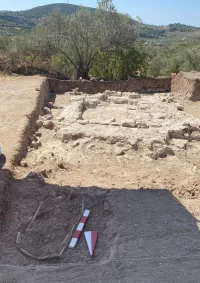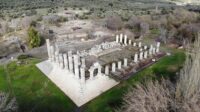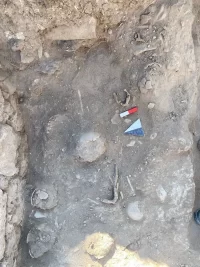 A monumental tomb from the Roman era has been unearthed at the Apollon Smintheus Sanctuary in the village of Gülpınar, Çanakkale, western Turkey. The bones had been disturbed and were found mixed together, but so far the skeletal remains of more than 10 individuals, adults and children, were discovered in the tomb. These were likely to be members of wealthy families, able to commission a large tomb at a very important sacred site.
A monumental tomb from the Roman era has been unearthed at the Apollon Smintheus Sanctuary in the village of Gülpınar, Çanakkale, western Turkey. The bones had been disturbed and were found mixed together, but so far the skeletal remains of more than 10 individuals, adults and children, were discovered in the tomb. These were likely to be members of wealthy families, able to commission a large tomb at a very important sacred site.
Smintheus has been interpreted to mean “Lord of Mice,” an epithet for Apollo first recorded by Homer in Book I of The Iliad, although the root of the word is not Greek and Homer never explains its meaning. Before the Trojan War even starts, Agamemnon, king of Mycenae, sacks the city of Chryse, kidnapping Chryseis, daughter of Chryses, priest of Apollo at the city’s sanctuary. When Agamemnon spurns Chryses’ offer of a rich ransom for the return of his daughter and throws in some insults to the god he represents while he’s at it, the priest prays to Apollo, addressing him as “O, Sminthian,” and asks him to send a plague to punish the Greeks for their offenses. Apollo is glad to help.
 The Smintheion temple was built in the ancient town of Hamaxitus around 150 B.C. in Ionic style. Pieces of the entablature have survived, decorated with scenes from the Iliad. Fragments of a monumental statue more than 16 feet high have been found at the site, and according to coins and ancient sources, the statue depicted Apollo trampling a mouse. The deity was believed to protect farmers from the scourge of crop-devouring mice.
The Smintheion temple was built in the ancient town of Hamaxitus around 150 B.C. in Ionic style. Pieces of the entablature have survived, decorated with scenes from the Iliad. Fragments of a monumental statue more than 16 feet high have been found at the site, and according to coins and ancient sources, the statue depicted Apollo trampling a mouse. The deity was believed to protect farmers from the scourge of crop-devouring mice.
 It was the second most important temple in the Troas region of Anatolia, and the sanctuary precinct was expanded during the Roman period to include two large public baths where pilgrims cleansed and purified themselves before worship, seven water cisterns to supply the baths and the sacred road connecting the temple to the city of Alexandria Troas 20 miles to the north.
It was the second most important temple in the Troas region of Anatolia, and the sanctuary precinct was expanded during the Roman period to include two large public baths where pilgrims cleansed and purified themselves before worship, seven water cisterns to supply the baths and the sacred road connecting the temple to the city of Alexandria Troas 20 miles to the north.
Excavations have been carried out regularly at the temple site since 1980. This year’s dig season (June 15th-October 1st) uncovered the remains of two tombs and the foundations of several buildings.
Hüseyin Yaman, a member of the excavation team said: “We aim not only to acquire information about the burial traditions of individuals and communities that once existed here but also to contribute to the delineation of the distribution area of sacred structures, or in other words, to determine the boundaries of the sacred area. In line with this goal, in the excavations conducted at three different points, we revealed remnants of two tombs alongside foundational remains of some structures. Based on the artifacts found in the only room that seemed to have survived with intact foundations in the monumental tomb, we estimate its origin to be approximately 2,000 years ago, around the first century A.D.”
Found? last week?